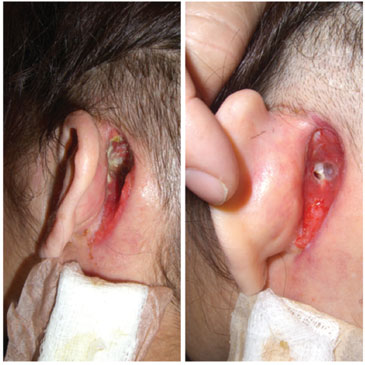INTRODUCTIONSystemic lupus erythematosus (SLE) is a chronic inflammatory autoimmune disease, whose treatment with corticosteroids and immunosuppressive drugs contributes to the onset of opportunistic infection by
Mycobacterium tuberculosis.
1,2 The extrapulmonary form of tuberculosis predominates in patients with lupus.
1 This bacterium can affect the middle ear trough the Eustachian tube or externally by tympanic perforation.
3,4 Tuberculous otitis media (TOM) is a rare disease, accounting for 0.05% to 0.9% of chronic otitis media,
4,5 although it is significantly more common in SLE (3.6% to 11.6%).
2 The clinical triad of TOM is painless otorrhea, tympanic membrane perforation, and facial paralysis; ear pain can also be present.
4 Late diagnosis of TOM is common and associated with complications such as mastoiditis and hearing loss.
3 The present case is a report of tuberculous otomastoiditis in an adult patient with SLE.
CASE REPORTILS, a 44-year-old female homemaker complained of sudden fullness in the left ear a year before, followed by daily serosanguineous to purulent otorrhea, with progressive hearing loss and tinnitus. She denied prior otorrhea, vertigo, or contact with tuberculosis. She had received prior treatment with amoxicillin/clavulanate, ciprofloxacin, and topical gentamicin/betamethasone. The patient had SLE, controlled with prednisone 10 mg/day. She had no cervical lymphadenopathy and the oral cavity, pharynx, and rhinoscopy were normal, with normal VII function bilaterally. The right otoscopy was normal; the left otoscopy disclosed whitish mucous secretion at the bottom of the ear canal. Laboratory tests were normal. Computed tomography (CT) showed pneumatized mastoids, with the left appearing opaque without erosions. Audiometry showed ipsilateral moderate mixed hearing loss. Chronic suppurative otitis media (CSOM) was suspected. A tympanomastoidectomy was performed, which disclosed friable whitish tissue in the mastoid and middle ear without cholesteatoma, anvil erosion, or misidentified stirrup. A mastoid debridement was performed, followed by specimen collection and fascia graft. Ossiculoplasty was left for a subsequent procedure.
The patient evdeveloped tinnitus, progressive wound dehiscence, otorrhea, and afacial paresis that recovered in three weeks. She was started on azathioprine and prednisone 40 mg. Two months later, the mastoid was fully exposed (Fig. 1), and tuberculosis was suspected. The material collected during surgery was insufficient to establish the diagnosis. She had a non-reactive PPD and normal chest X-ray. A biopsy performed through the dehiscent incision showed extensive granulomatous reaction with, giant multinucleated epithelioid cells with focal necrotic areas. Fungus and AFB culture results were negative. Considering these data, the physicians decided to establish an early antituberculosis regimen: rifampicin, isoniazid, pyrazinamide, and ethambutol for two months, followed by isoniazid and rifampicin for seven months.
6 Improvement in healing was observed after 30 days (Fig. 1). After three months, the incision was closed.

Figur 1 Dehiscent retroauricular incision. Left image: aspect 80 days after surgery; and on the right: 30 days after start of treatment for tuberculosis, showing improved healing.
One year later, she remained with tinnitus, discrete otorrhea, and tympanic perforation. Audiometry showed no responses at 6 and 8 kHz, with preservation of thresholds at the other frequencies.
DISCUSSIONThe scarcity of TOM reports delays diagnosis.
3-5 In this case, the investigation was prompted by the unfavorable evolution (wound dehiscence). The initial clinical presentation suggested CSOM with more aggressive evolution, which was attributed to the use of corticosteroids and SLE.
1,2 Perhaps the foreknowledge that TOM in SLE is much more common than in the general population2 would have led to a more unequivocal investigation of this disease and more thorough consideration of surgical indication.
However, it is difficult to say whether the diagnosis would be confirmed without surgery, due to the greater difficulty in collecting expressive material. Even with the abundant material collected through the incision dehiscence, a definitive diagnosis was not possible, which is consistent with the literature that indicates difficulty in the etiological diagnosis;
3,5 this diagnosis is confirmed only by prompt improvement in evolution after starting the antituberculosis medication. Another aspect to be discussed is the tomographic image showing normal mastoid pneumatization, not expected in cases of CSOM, which should alert the clinician of rarer diagnostic possibilities.
3FINAL CONSIDERATIONSImmunosuppressive conditions, such as lupus and other autoimmune diseases, as well as the use of corticosteroids, associated with atypical behavior of otitis or other otorhinolaryngology infections, should alert the physician to the presence of specific infections, and among them, tuberculosis.
CONFLICTS OF INTERESTThe authors declare no conflicts of interest.
REFERENCES1. Pereira JCB. Associação entre lúpus eritematoso sistêmico e tuberculose - revisão crítica. Rev Port Pneumol. 2008;14:843-55.
2. Sousa DC, Medeiros MMC. Lúpus eritematoso sistêmico e tuberculose renal: descrição de nove casos. Rev Bras Reumatol. 2008;48:2-6.
3. Pinho MM, Kós AOA. Otite média tuberculosa. Braz J Otorhinolaryngol. 2003;69:829-37.
4. Sens PM, Almeida CIR, Valle LO, Costa LHC, Angeli MLS. Tuberculose de orelha, doença profissional? Braz J Otorhinolaryngol. 2008;74:621-7.
5. Juanet JI, Acuña A, Casar C. Otomastoiditis tuberculosa: a propósito de un caso. Rev Chil Enf Respir. 2011;27:43-8.
6. Ministério Da Saúde. Programa Nacional de Controle da Tuberculose. Nota técnica sobre as mudanças no tratamento da tuberculose no Brasil para adultos e adolescentes, 2009. Available from:
http://portal.saude.gov.br/portal/arquivos/pdf/nota_tecnica_versao_28_de_agosto_v_5.pdfUniversidade Estadual de Maringá, Maringá, PR, Brazil
Corresponding author.
S. Hirata
E-mail:
s_callefihirata@hotmail.comReceived on August 28, 2012.
Accepted on March 23, 2013.


